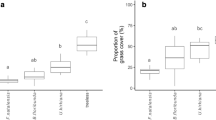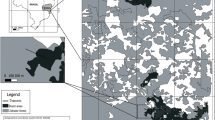Abstract
The control of exotic and invasive species in areas undergoing recovery is a challenge for ecological restoration and this problem may be even greater in urbanized areas. This study evaluated the seed bank and seed rain of a 5-year-old riparian forest located at the metropolitan region of Belo Horizonte in southeast Brazil, and verified changes over time in the abundance and species richness and whether planted species already were providing propagules to the site. At the forest, fifteen parcels of 100 m2 were distributed randomly and soil samples were collected thrice (October 2011, March 2012 and July 2012) to evaluate the seed bank. Seed traps were installed in nine parcels to collect propagules over 1 year. Propagules were segregated and germinate at greenhouse. Species richness and abundance were estimated, and variance and similarity were quantified. In total, 86 species were recorded in the seed banks, 41.9% natives and 33.7% exotics, with the predominance of herbs (87.2%) and only 7% of trees. Species classified as weeds amounted to 52.3%. In the seed rain 642 seedlings germinated but they belonged to only 10 species, half of them were exotics. Regarding life forms, half of the species were arboreal and dominated the samples, highlighting the exotic species Melia azedarach. The species richness of the seed bank did not differ by season, unlike the seed rain which varied significantly by month. Seed bank and seed rain species had a very low floristic similarity with the list of planted species, suggesting that few planted trees had dispersed or were stocking propagules. Many non-planted species were recorded, mostly exotics and/or invasive that were probably derived from the surrounding urban matrix. These might interrupt the successional dynamics of the restoration forest and compromise the restoration process in the medium and long-terms. Our results highlight: (1) the importance of monitoring areas undergoing restoration; (2) that restoration methods and management actions directed to control exotic and invasive species are particularly important for sites in urban regions; and (3) the relevance of conserving forest fragments as sources of propagules for nearby areas.


Similar content being viewed by others
References
Antunes NB, Ribeiro JF (1999) Aspectos fenológicos de seis espécies vegetais em matas de galeria do Distrito Federal. Pesquisa Agropecuária Brasileira 34:1517–1527
Apg III (2009) An update of the Angiosperm Phylogeny Group classification for the orders and families of flowering plants: APG III. Bot J Linn Soc 161:105–121
Assembleia Legislativa de Minas Gerais (ALMG) (2013) Municípios mineiros: Sabará. http://www.almg.gov.br/consulte/info_sobre_minas/index.html?aba=js_tabMunicipios&sltMuni=567. Accessed 12 March 2013
Bertoncini AP, Rodrigues RR (2008) Forest restoration in an indigenous land considering a forest remnant influence (Avaí, São Paulo State, Brazil). For Ecol Manag 255:513–521
Blackham GV, Thomas A, Webb EL, Corlett RT (2013) Seed rain into a degraded tropical peatland in Central Kalimantan, Indonesia. Biol Conserv 167:215–223
Borgmann KL, Rodewald AD (2005) Forest restoration in urbanizing landscapes: interactions between land uses and exotic shrubs. Restor Ecol 13:334–340
Bowers K, Boutin C (2008) Evaluating the relationship between floristic quality and measures of plant biodiversity along stream bank habitats. Ecol Ind 8:466–475
D’Antonio C, Meyerson LA (2002) Exotic plant species as problems and solutions in ecological restoration: a synthesis. Restor Ecol 10:703–713
Funk JL, Cleland EE, Suding KN, Zavaleta ES (2008) Restoration through reassembly: plant traits and invasion resistance. Trends Ecol Evol 23:695–703
Ho M, Richardson CJ (2013) A five-year study of floristic succession in a restored urban wetland. Ecol Eng 61:511–518
Holl KD, Aide TM (2011) When and where to actively restore ecosystems? For Ecol Manag 261:1558–1563
Instituto Hórus de desenvolvimento e conservação ambiental (2013) Base de dados nacional de espécies exóticas invasoras, I3 N Brasil. http://i3n.institutohorus.org.br/www/accessed. 15 March 2013
Jesus FM, Pivello VR, Meirelles ST, Franco GADC, Metzger JP (2012) The importance of landscape structure for seed dispersal in rain forest fragments. J Veg Sci 23:1126–1136
Lamb D, Gilmour D (2003) Rehabilitation and restoration of degraded forests. IUCN and WWF Publication, Switzerland, pp 31–68
List of Species of the Brazilian Flora (2016) Rio de Janeiro Botanical Garden. http://floradobrasil.jbrj.gov.br. Accessed 28 January 2016
Lorenzi H (2008) Plantas daninhas do Brasil: terrestres, aquáticas, parasitas e tóxicas (4rd edition). Instituto Plantarum, Nova Odessa, pp 10–670
Lorenzi H, Souza HM, Torres MAV, Bacher LB (2003) Árvores exóticas no Brasil: madeireiras, ornamentais e aromáticas. Nova Odessa, Instituto Plantarum, pp 8–380
Mack MC, D’Antonio CM (1998) Impacts of biological invasions on disturbance regimes. Trends Ecol Evol 13:195–198
Martínez-Ramos M, Soto-Castro A (1993) Seed rain and advanced regeneration in a tropical forest. Vegetatio 107(108):299–318
Martins SV (2011) Recuperação de matas ciliares, vol 2. Viçosa, Aprenda Fácil, pp 100–240
Martins CC, Silva WR (1994) Estudos de bancos de sementes do solo. Inf Abrates 4:49–56
Martins SV, Almeida DP, Fernandes LV, Ribeiro TM (2008) Seed bank as indicator of restoration of a kaolin mining-degraded area in Brás Pires. Minas Gerais Rev Árvore 32:1081–1088
McEuen AB, Curran LM (2004) Seed dispersal and recruitment limitation across spatial scales in Temperate forest fragments. Ecology 85:507–518
McKinney ML (2002) Urbanization, biodiversity, and conservation. Bioscience 52:883–890
Metzger JP (2000) Tree functional group richness and landscape structure in a Brazilian Tropical fragment landscape. Ecol Appl 10:1147–1161
Müller F, Lenz R (2006) Ecological indicators: theoretical fundamentals of consistent applications in environmental management. Ecol Indic 6:1–5
Pakeman RJ, Small JL (2005) The role of the seed bank, seed rain and the timing of disturbance in gap regeneration. J Veg Sci 16:121–130
Pivello VR, Petenon D, Jesus FM (2006) Seed rain in Atlantic forest fragments (São Paulo State, SP, Brazil) with different connectivity, forest structure and distance to edge. Acta Bot Brasilica 20:845–859
Podadera DS, Engel VL, Parrota JA, Machado DL, Sato LM, Durigan G (2015) Influence of removal of a non-native tree species Mimosa caesalpiniifolia Benth. On the regenerating plant communities in a tropical semideciduos forest under restoration in Brazil. Environ Manag 55:1148–1158
R Core Team (2015) R: a language and environment for statistical computing. R Foundation for Statistical Computing, Vienna, Austria. https://www.r-project.org/
Reis A, Bechara FC, Tres DR (2010) Nucleation in tropical ecological restoration. Scientia Agricola 67:244–250
Ribbens E, Silander JA Jr, Pacala SW (1994) Seedling recruitment in forests: calibrating models to predict patterns of tree seedling dispersion. Ecology 75:1794–1806
Rodrigues RR, Lima RAF, Gandolfi S, Nave AG (2009) On the restoration of high diversity forests: 30 years of experience in the Brazilian Atlantic Forest. Biol Conserv 142:1242–1251
Schultz RC, Isenhart TM, Simpkins WW, Colleti JP (2004) Riparian forest buffers in agroecoystems—lessons learned from the Bear Creek Watershed, central Iowa, USA. Agrofor Syst 61:35–50
Society for Ecological Restoration (SER) (2004) The SER primer on ecological restoration, Version 2. Society for Ecological Restoration Science and Policy Working Group. http://www.ser.org/resources. Accessed 12 March 2013
Tererai F, Gaertner M, Jacobs SM, Richardson DM (2015) Resilience of invaded riparian landscapes: the potential role of soil-stored seed banks. Environ Manag 55:86–99
Tres DR, Sant’anna CS, Basso S, Langa R, Júnior UR, Reis A (2007) Banco e chuva de sementes como indicadores para a restauração ecológica de matas ciliares. Revista Brasileira de Biociências 5:309–311
Wang J, Ren H, Yang L, Li D, Guo Q (2009) Soil seed banks in four 22-year-old plantations in South China: implications for restoration. For Ecol Manag 258:2000–2006
Acknowledgements
Authors are grateful to Dra Maria Rita S. Muzzi of the Federal University of Minas Gerais that provided access to the studied site; to the Department of Transport of the Federal University of Ouro Preto for logistical support; and to Coordination for the Improvement of Higher Educational Personnel (CAPES) for the master’s scholarship of the first author.
Author information
Authors and Affiliations
Corresponding author
Additional information
Project funding: This study is supported by Coordination for the Improvement of Higher Educational Personnel (CAPES).
The online version is available at http://www.springerlink.com
Corresponding editor: Zhu Hong
Electronic supplementary material
Below is the link to the electronic supplementary material.
Rights and permissions
About this article
Cite this article
Londe, V., de Sousa, H.C. & Kozovits, A.R. Exotic and invasive species compromise the seed bank and seed rain dynamics in forests undergoing restoration at urban regions. J. For. Res. 28, 1019–1026 (2017). https://doi.org/10.1007/s11676-017-0370-2
Received:
Accepted:
Published:
Issue Date:
DOI: https://doi.org/10.1007/s11676-017-0370-2




